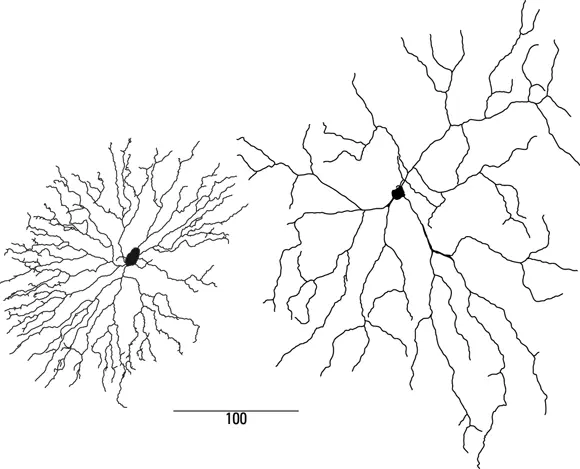The plasma membranes of cells are not totally impermeable to water, because, among other reasons, membranes have water-permeable channels called aquaporins. This causes a net loss of water inside our cells so that they become hyperconcentrated with ions and die. Neurons, like other cells, have a variety of mechanisms for dealing with concentration balances between their cytoplasm and the extracellular fluid.
Responding to osmotic challenges
Osmotic imbalances are detected by a variety of sensors in cells, which respond in many ways such as with secretion, enzyme production, or changes in gene expression. Mechanosensitive channels in cell membranes respond to mechanical stress such as stretching of the membrane. These channels open or close to allow bulk flow of ions through the membrane to balance between different concentrations inside versus outside. Protein pump molecules may selectively bring in or expel soluble ions in response to different total ionic concentrations inside versus outside the cell.
 A recently discovered channel family termed TRPV (short for transient receptor potential vanilloid ) responds to osmotic stress by allowing calcium influx. The increased calcium concentration inside the cell regulates volume by activating calcium-dependent potassium channels. Defective TRPV channels are associated with cystic fibrosis.
A recently discovered channel family termed TRPV (short for transient receptor potential vanilloid ) responds to osmotic stress by allowing calcium influx. The increased calcium concentration inside the cell regulates volume by activating calcium-dependent potassium channels. Defective TRPV channels are associated with cystic fibrosis.
Moving water with aquaporins
Although phospholipid plasma membranes have some limited permeability to water, we know that in many neurons water channels called aquaporins control much of this movement. Aquaporin channels in the membrane tend to equilibrate water between the cytoplasm and extracellular fluid. In addition, aquaporin channels can be up or down regulated over longer time scales. Aquaporin channel deficiencies are involved in some types of diabetes.
Knowing the Neuron: Not Just Another Cell
At the most fundamental level, neurons differ from other cells because they express different portions of the DNA sequence, leading to the production of different proteins. These proteins result in two major types of differences between neurons and other cells:
Structure
Membrane receptors and ion channels
The most obvious feature of most neurons is their extensive dendritic branching patterns. Most neurons have several primary dendritic branches that leave the cell body. These typically divide numerous times (out to the tenth order or more) forming a tree-like structure often called the dendritic tree or dendritic arborization. Figure 2-4 shows two cells from a rabbit retina with very different arborizations.

Figure 2-4:Two neurons from a rabbit retina: a starburst amacrine cell (left), and a directionally selective ganglion cell (right).
The dendritic arborization is where neurons receive most of their synaptic input — typically hundreds or thousands of synapses. These synapses are almost always a mixture of excitatory and inhibitory inputs. In many cases, the excitatory inputs are on dendritic spines, which are little mushroom-like appendages on the dendrites.
In any region of the nervous system are usually a finite number of distinct dendritic neuronal forms, between 10 and 30. Neurons are anatomically classified by the types of branching patterns using parameters such as total size, branching density, and the location of branches relative to other neurons. If you use a microscope to look at unstained tissue sections, these branching structures are usually not evident. Stains are necessary to reveal the structure of individual neurons.
 The location of the dendritic branches with respect to nearby neurons determines some of what inputs may synapse on the neuron. The form of the branching structure determines how those inputs interact. Picture thousands of excitatory and inhibitory inputs going on and off in complicated patterns, producing a complex pattern of excitation and inhibition in the postsynaptic neuron, which is constantly changing. This neuron may itself synapse on hundreds of other neurons. Multiply this by 80 to 100 billion neurons and you have a circuit more complicated than any computer we have today!
The location of the dendritic branches with respect to nearby neurons determines some of what inputs may synapse on the neuron. The form of the branching structure determines how those inputs interact. Picture thousands of excitatory and inhibitory inputs going on and off in complicated patterns, producing a complex pattern of excitation and inhibition in the postsynaptic neuron, which is constantly changing. This neuron may itself synapse on hundreds of other neurons. Multiply this by 80 to 100 billion neurons and you have a circuit more complicated than any computer we have today!
Neurons also have an axon, their typical output structure. Usually a single process leaves the cell body and branches before forming synapses with other neurons. The axon conducts action potentials, millisecond-long electrical pulses that move from the cell body to the synaptic terminals of the axon, where they cause neurotransmitter to be released onto postsynaptic neurons.
Understanding what neurons do
Neurons enable sensation, communication, and movement in animals. They do this using their membrane receptors, ion channels, and exocytosis mechanisms. Reception and exocytosis themselves are both mediated by gated ion channels.
Taking in information: Receptors
Different types of receptors detect various kinds of energy from the environment. Here are a few examples:
Photoreceptors capture photons of light.
Auditory hair cells respond to acoustic energy, or sounds.
Mechanoreceptors are located in the skin and respond to touch.
Olfactory and taste receptors respond to molecules interacting with receptors in our noses and tongues.
 Neurons also respond to each other via receptors for various neurotransmitters. Some neurons respond to hormones circulating in the extracellular space or bloodstream. Also, specific neural responses to extracellular ion concentrations can occur.
Neurons also respond to each other via receptors for various neurotransmitters. Some neurons respond to hormones circulating in the extracellular space or bloodstream. Also, specific neural responses to extracellular ion concentrations can occur.
Transforming information: Interneurons
After neurons receive information from either the environment or other neurons, they process that information using electrotonic potentials and ion concentrations that interact within the neuron. Neurons then transmit information to other neurons or to muscles or glands.
 A neuron’s dendritic tree may have thousands of excitatory and inhibitory synaptic inputs, each of which may be modulated in a complex pattern over time. The way different inputs to the neuron interact also depends on their locations in the dendritic tree. Inputs that are near to each other may interact in a nonlinear way, exhibiting thresholds, saturation, multiplicative interactions, and other complex interactions.
A neuron’s dendritic tree may have thousands of excitatory and inhibitory synaptic inputs, each of which may be modulated in a complex pattern over time. The way different inputs to the neuron interact also depends on their locations in the dendritic tree. Inputs that are near to each other may interact in a nonlinear way, exhibiting thresholds, saturation, multiplicative interactions, and other complex interactions.
In most neurons, all the inputs and their interactions result in a net flow of current into the cell body, or soma, and the initial segment of the axon. If the voltage produced by this current is below threshold, it doesn’t produce any spikes. Above this threshold, the rate of action potentials, or spikes, is generally proportional to the net excitatory (depolarizing) current. The spikes are sent down the axon where, at the axon terminals, neurotransmitter is released. Neurons may release neurotransmitter on neurons a few tens of micrometers away or a meter or more away.
Читать дальше

 A recently discovered channel family termed TRPV (short for transient receptor potential vanilloid ) responds to osmotic stress by allowing calcium influx. The increased calcium concentration inside the cell regulates volume by activating calcium-dependent potassium channels. Defective TRPV channels are associated with cystic fibrosis.
A recently discovered channel family termed TRPV (short for transient receptor potential vanilloid ) responds to osmotic stress by allowing calcium influx. The increased calcium concentration inside the cell regulates volume by activating calcium-dependent potassium channels. Defective TRPV channels are associated with cystic fibrosis.
 The location of the dendritic branches with respect to nearby neurons determines some of what inputs may synapse on the neuron. The form of the branching structure determines how those inputs interact. Picture thousands of excitatory and inhibitory inputs going on and off in complicated patterns, producing a complex pattern of excitation and inhibition in the postsynaptic neuron, which is constantly changing. This neuron may itself synapse on hundreds of other neurons. Multiply this by 80 to 100 billion neurons and you have a circuit more complicated than any computer we have today!
The location of the dendritic branches with respect to nearby neurons determines some of what inputs may synapse on the neuron. The form of the branching structure determines how those inputs interact. Picture thousands of excitatory and inhibitory inputs going on and off in complicated patterns, producing a complex pattern of excitation and inhibition in the postsynaptic neuron, which is constantly changing. This neuron may itself synapse on hundreds of other neurons. Multiply this by 80 to 100 billion neurons and you have a circuit more complicated than any computer we have today!










